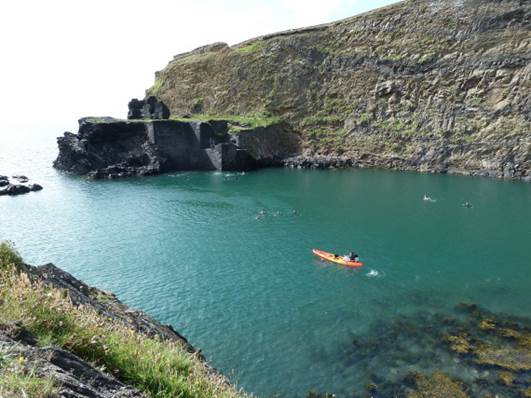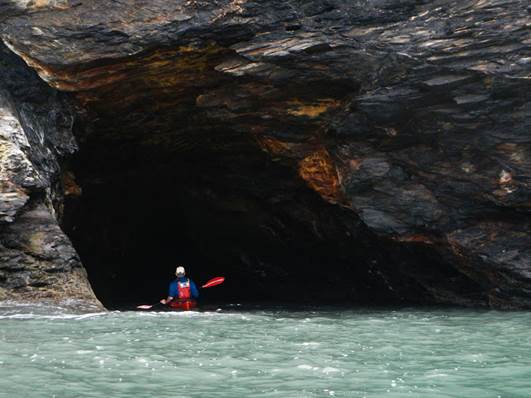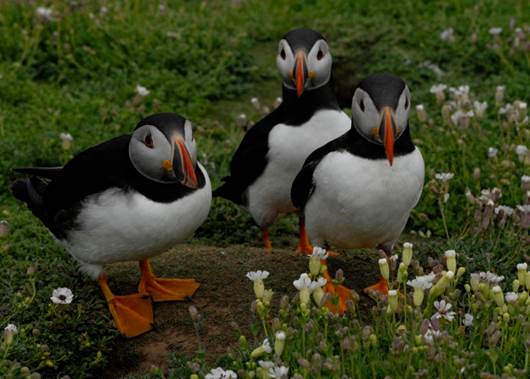Famous for its stunning cathedral nestled
at the bottom of a valley, there are great opportunities for some photography
in and around the cathedral grounds. Further West leads you down to St.
Justinian’s Lifeboat Station with great views across to Ramsey Island, whilst
heading further North will take you past Whitesands Bay and up towards
Abereiddi Bay. There’s a superb area here called ‘The Blue Lagoon’, which is
where sea water has filled in a disused slate quarry producing a distinct
turquoise hut to the water. There are many more bays and coves you’ll go
through as you travel North East on your approach to Fishguard, and the white
tower at Strumble Lighthouse will greet you. The lighthouse itself sits on a
rocky outcrop and provides a good main feature to any landscape image. The
lower town at Fishguard, further East, can provide good photographic interest
with old boats in the harbour along with historic terrace houses. From here now
until the border at Cardigan, you’ll catch a distinct difference in terrain in
a short space of time. There’s golden sands in the estuary at Newport and
unique cliff rock formations and folds, especially at Ceibwr Bay. It’s well
worth a visit here in early Spring when the cliffs turn to a soft pink as the
Thrift blossoms and carpets the area. There’s also a quite special rock feature
called the ‘Witches Cauldron’, which is where a cave’s roof has collapsed. In
bad weather the sea here appears to boil within it, lending it, its name.
Although he main draw in Pembrokeshire is the coastline, there’s plenty to see
and shoot inland. The heritage of Britain is built around its castles, and in
Pembrokeshire it’s no exception. There are no less than eleven castles in the
small county of Pembrokeshire; the main ones being at Carew, Llawhaden,
Pembroke and Manorbier. Carew, similar to Pembroke, is situated on the shore of
its millpond, making fantastic photographic opportunities with reflection shots
always producing interesting and compelling images. Both castles also allow
pretty much three hundred and sixty degrees of viewing, so finding the right
angle in any light should be made easier. Manorbier and Llawhaden are more
situated amongst vegetation with Manorbier nestled near the sea revealing great
views to the beach. But it’s not only castles that give you a great feeling of
the past. Pembrokeshire is, of course, renowned for its Preseli Mountains,
which is the source of the famous ‘Bluestones’ used at Stonehenge. But the
county’s magical landscape also has a great quantity of stone circles, standing
stones and burial chambers. The most famous of which are Pentre Ifan, Coetan
Arthur and Carreg Smason. All dating back from the Megalithic period; these now
eroded graves stand proud amongst the landscape and in fantastic locations,
making a great additional feature to any image.

Blue
Lagoon at Abbereiddy, Pembrokeshire Coast National Park
Considering the county is mostly built
around or near to water, there aren’t many consistently good locations for
waterfall shoots apart from, that is, Cenarth Falls. Some could argue it’s only
just inside Pembrokeshire thanks to its location sitting on the border with
neighbouring Ceredigionshire, but this still doesn’t detract from the fact you
can come away with some great images. A very unique mill and stonework bridge
is located next to the falls helping to aid composition and include its
surroundings.

In
to the Witches Cauldron
Pembrokeshire also has a very diverse
collection of flora and fauna, differing geographically across the county.
Throughout the year there’s always something to spot, with birds being
especially abundant during any month. As mentioned, Puffins are the star of the
show in summertime, along with many of the migrating birds that come to feast
on your shores. It’s also a mecca for wading birds in Autumn and over Winter;
with Geese and Wildfowl flocking down from the Arctic. Bird of Prey highlights
in the county are Short Eared Owls, which nest on Skomer and wintering Hen
Harriers, which inhabit a few sites around the County at Dowrog Common and
Plumstone Mountain; the latter location being a fantastic place to view the
mass gathering of hundreds of thousands (sometimes millions) of Starlings
across the sky. Another big draw is the Chough, a rarer corvid species, which
resided along the coastal cliffs at Stack Rocks and around the Deer Park near
Marloes. They can be distinguished by their blood red beans and legs. Woodland
birds also make the passage over come Spring-time and at Canaston and
Bosherston Woods you’ll pretty much tick everything off in your spotters guide
book. Wilst we don’t have many large land mammals in Pembrokeshire (Red Deer
reside on Ramsey Island), we do have our fair share of sea life all year round.
During the latter part of Summer through to Autumn is the pupping season for
the Grey Seals that breed here and a stroll around the Deer Park, along the
Marloes Peninsular or most of the Atlantic coastline will, nine times out of
ten, reveal some fantastic views of pups hauled up on the rocky coves, with
mums not too far away. Porpoise are a very common sight around the West coast
on a calm day and to the north around Strumble Head. Even Basking Sharks are
sighted in summer months. So, as you can see from the associated images
gathered here, you really are spoilt for choice along the Pembrokeshire coast
with the amount of diversity on offer, and it’s a great place to visit at any
time of year. Be it golden beaches, varied wildlife, offshore islands or rugged
cliffs; it really has it all for anyone to experience and enjoy.

The
main draw to Skomer in the summer months is the charismatic Puffin
Getting there
By road
As with most places in Britain, road
networks have improved a lot over the years so follow the M4 west, and then the
A roads to St. Clears. Here, you choose to head to the North of the county, or
the South. Either way you’re in for a real treat and, if possible, pick the
back roads to discover some off-the-beaten-track views.
By train
There are great train links throughout
Wales and to reach Pembrokeshire, you’ll need to change at Swansea. Then, as is
the case with the roads, due to the Milford Haven waterway that divides the
county horizontally, there’s fork at Whitland to head to the North or South of
the county.
By air
The downside (or upside) to Pembrokeshire
and most of West Wales, for that matter, is that the nearest main airport is
Cardiff; some two hours East by car. There is a small airport at Haverfordwest,
but it’s mainly for recreational use. However, chartered planes do land there
from time to time.
By bus
Many companies run tours to Pembrokeshire
along with the usual National Express, which tends to reach the main county
towns. Once you’re in the county, there are great bus links including the
Puffin Shuttle, which takes you right to the hard to reach places, including
most of the beaches, so this makes for a great cheap way to see the seaside.